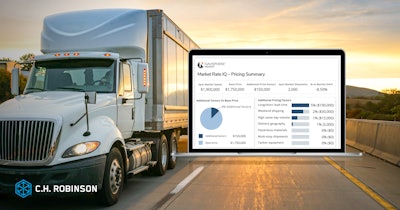
C.H. Robinson this week launched its Market Rate IQ tool, which shows companies how their spot rates compare to a third-party benchmark and breaks down where they could save money.
Created by C.H. Robinson’s technology incubator, C.H. Robinson Labs, Market Rate IQ shows shippers which factors in their U.S. spot pricing are market-driven and which they can control while also incorporating DAT’s RateView, which is based on $110 billion in shipment data across 68,000 shipping lanes. During its incubation phase, C.H. Robinson said Market Rate IQ uncovered $75 million in potential customer savings across $1.2 billion in spot freight spend.
“Virtually every company is looking for a solution to help them navigate the spot market, so we built one,” said Tim Gagnon, head of Robinson Labs and C.H. Robinson’s vice president of analytics and data science. “Now, for the first time, they can see what’s driving their rates and what they can do about it. Then we take that transparency a step further and show them how their rates compare to the average for each of their shipping lanes and locations. It’s like going to the grocery store and instantly being able to see how the price of everything on your list compares to the market. Who doesn’t want to know if they’re paying more than market?”
Shippers have increasingly turned turn to the spot market more as global disruptions ripple through supply chains, requiring more last-minute changes and short-term decisions. Since January 2020, load postings are up 176% while postings from trucks looking for loads are down 5% – an imbalance that's driving up rates up. Companies often cope with pricing pressure by spreading spot freight among many transportation providers, even though that added effort doesn’t always result in better rates.
C.H. Robinson said it uncovered during the platform's incubation phase the top five reasons customers paid more than they might have needed to, even when their rates were below market average. They were:
1. Lead time. Carriers charge a premium when given too little lead time for pick up.
2. Uneven freight. Because any given shipping lane has a finite number of trucks, putting too much freight in the same lane on the same day instead of spreading it out means you might be paying extra for carriers elsewhere to drive out of their way.
3. Weekend pickup. To avoid the higher cost of Saturday and Sunday pickups, some companies might find it beneficial to run freight out of their warehouses only five days a week.
4. Multiple stops. Adding too many stops to fill a truck has diminishing returns. Other optimization strategies could be more cost-effective.
5. Delivery geography. Carriers charge more if they have to drive empty to get their next load. When shippers have spot loads going to a remote destination, they could save money by working with a logistics partner who can pair up loads originating nearby.
“Market Rate IQ gives us this window into our spot rates that just wasn’t possible before,” said Terry Laluk, Senior Director of Logistics of Valmont, a global provider of infrastructure for transit, utilities, agriculture and other industries. “We have confidence and assurance that we’re getting good rates, especially under market conditions no one has ever experienced. But it’s also so easy to see where adjusting our shipping strategy could add to our bottom line. We just started using the tool, and the potential for significant cost savings is already clear.”
Market Rate IQ is offered within C.H. Robinson’s Navisphere platform and powered by C.H. Robinson’s freight dataset.












